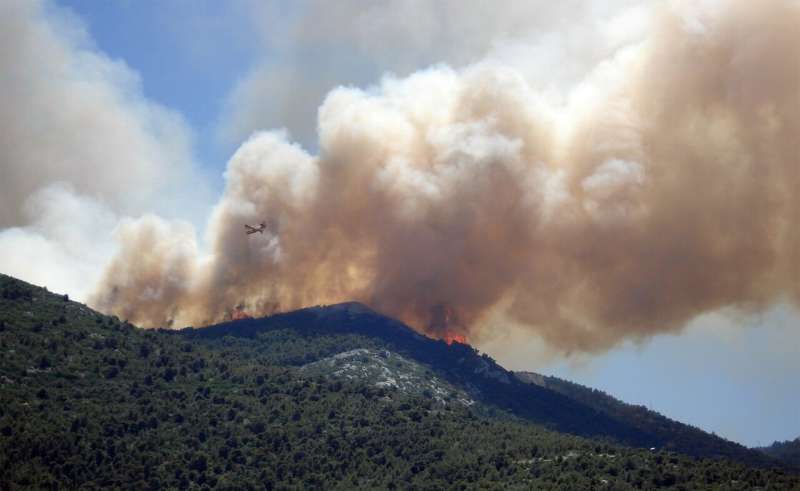Credit: Pixabay/CC0 public domain
In recent years, the plumes of smoke creeping up from western wildfires have grown, with more smoke and aerosols that can spread further and affect air quality over a wider area. The likely cause is climate change, with reduced precipitation and increased drought in the western US intensifying wildfire activity.
“Should these trends continue into the future,” said Kai Wilmot, a postdoctoral researcher in the Department of Atmospheric Sciences at the University of Utah, “it would suggest that increased wildfire activity in the West in the US is likely to correspond to a increasingly frequent air quality deterioration at local to continental scales.”
The study is published in Scientific Reports and supported by the iNterdisciplinary EXchange for Utah Science, or NEXUS, at the University of Utah.
Smoke height
To assess trends in smoke plume heights, Wilmot and U colleagues Derek Mallia, Gannet Haller, and John Lin modeled plume activity for approximately 4.6 million smoke plumes in the western US and Canada between 2003 and 2020 where ecosystems are similar. such as the Great Basin, the Colorado Plateau, and the Wasatch and Uinta Mountains in Utah), the researchers looked for trends in maximum smoke plume height measured in August and September in each region of each year.
In California’s Sierra Nevada ecoregion, the team found that maximum plume heights increased by an average of 230 m per year. In four regions, maximum plume heights rose by an average of 100 m per year.
Why? Wilmot says plume heights are a complex interaction between atmospheric conditions, the size of the fire, and the heat released by the fire.
“Given the climate-driven trends towards increasing atmospheric drought, decreasing snow cover, higher temperatures, etc., we are seeing larger and more intense wildfires in the western US,” he says. “And this gives us bigger burns and more intense burns.”
The researchers also used a smoke plume simulation model to estimate the plumes’ mass and approximate trends in the amount of aerosols thrown into the atmosphere by wildfires. . . which is also increasing.
The smoke simulation model also estimated the occurrence of pyrocumulonimbus clouds — a phenomenon where plumes of smoke begin to create thunderstorms and their own weather systems. Between 2017 and 2020, six ecoregions experienced their first known pyrocumulonimbus clouds, and the trend suggests pyrocumulonimbus activity in the Colorado Plateau is becoming more frequent.
Higher plumes send more smoke to higher altitudes, where it can spread further, says John Lin, professor of atmospheric sciences.
“When smoke is transported to higher altitudes, it has the potential to be transported over longer distances, deteriorating air quality over a wider area,” he says. “So wildfire smoke can go from a more localized problem to a regional to even continental problem.”
Are the trends accelerating?
Some of the most extreme fire seasons have occurred in recent years. Does this mean the pace of the worsening fire trend is accelerating? It’s too early to tell, Wilmot says. Additional years of data are needed to determine if anything significant has changed.
“Many of the most extreme data points fall in the years 2017-2020, and some of the 2020 values definitely stick out above the rest of the time series,” he says. “Further, given what we know about the 2021 fire season, it seems likely that analysis of 2021 data would further support this finding.”
In Utah’s Wasatch and Uinta Mountains ecoregion, trends in plume height and aerosol amounts are increasing, but the trends are not as strong as those in Colorado or California. However, smoke from neighboring states often ends up in Utah’s mountain basins.
“As for the plume trends themselves, it seems Utah is not the epicenter of this problem,” Wilmot says. “However, given our position as generally downwind of California, trends in California plume top heights and wildfire emissions suggest a growing risk to Utah air quality from wildfire activity in the West.”
Wilmot says that while there are some things people can do to help the situation, such as preventing man-made wildfires, climate change is a much bigger and stronger force that is driving the trends of less precipitation, higher drought and more mature fire conditions in the world. West directs.
“The reality is that some of these [climate change] the effects are already ingrained, even if we cut emissions now,” adds Wilmot. “Looks like we’re mostly with it at this point.”
Wildfire smoke trends worsen for western US
Taylor Y. Wilmot et al, Wildfire plumes in the western US reach higher altitudes and inject more aerosols into the air as wildfire activity increases, Scientific Reports (2022). DOI: 10.1038/s41598-022-16607-3
Quote: Smoke plumes from western wildfires get bigger (2022, July 27) retrieved July 27, 2022 from https://phys.org/news/2022-07-western-wildfire-plumes-taller.html
This document is copyrighted. Other than fair dealing for personal study or research, nothing may be reproduced without written permission. The content is provided for informational purposes only.

